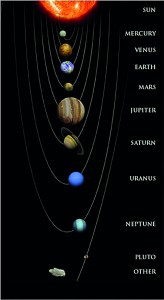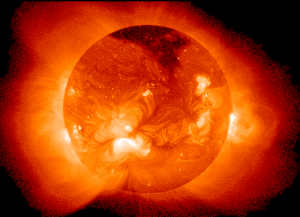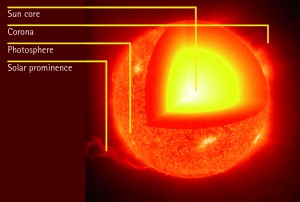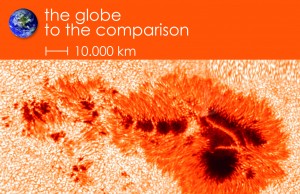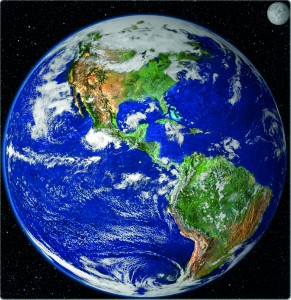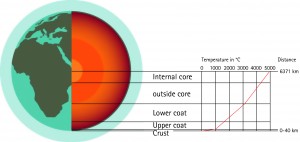The solar system
Our solar system is located between two spiral star concentrations, the Perseus arm and the Sagittarius arm, in a local branch of the Orion arm. It is about 15 light years north of the galactic symmetry plane and 26,000 light years from the center of the galaxy, around which our solar system revolves every 230 million years, a period of time equal to a galactic year. A 26,000-year cycle is the basis of cycle calendars used by the Maya, in the Vedas, in astrology and the Giza pyramids (see page 662, Galactic Conjunction and Volume II: DEI LEGACY, page 399 ff.)
Every star is also a sun and each sun is surrounded by a gravitational solar system that may be a planetary system or a simple star system.
A solar system is comprised of the sun, the planets revolving around it and their natural satellites, the dwarf planets and other small bodies such as comets, asteroids and meteoroids and all gas and dust particles which have been held together in a celestial order by the sun’s attractive force.
The people of earth are only beginning to understand the universe or even our own solar system. We have few insights into the planets and those we have are mostly of a material nature, based on the three-dimensional measuring devices available to modern science. We still know very little about the central star of our solar system, the sun, or about the planets: Mercury, Venus, Earth, Mars, Jupiter, Saturn, Uranus, Neptune and Pluto. The planets and stars are not there by mere coincidence and do not revolve as they do randomly. Is there anyone who has not wondered who or what controls all these paths and has for millions of years maintained this marvelous order? It is scarcely comprehensible to our relatively tiny minds.
Formation of the solar system
The current theory concerning the formation of the solar system is based on the nebular hypothesis, according to which the large planets arose at roughly the same time from a rotating cloud of gas and dust. The idea of this primordial cloud can be traced back to the German philosopher Immanuel Kant, who proposed it in his 1755 book “Allgemeine Naturgeschichte und Theorie des Himmels”. Today, we know that 4.6 billion years ago, there was a huge cloud of matter where our solar system is today; it and the surrounding stars, rotated around the center of the galaxy. Over 99% of the cloud consisted of hydrogen and helium and tiny dust particles, only micro millimeters across, which were generated by the Big Bang. The heavier elements and the volatile compounds were generated inside stars and released as stardust when those stars exploded. Pieces of the cloud of matter contracted under the influence of their own gravitational force and condensed, which led to the formation of several hundreds or even thousands of stars in a star cluster. Over several hundred million years, they have developed into free single or double stars and formed corresponding solar systems.
The sun
Our sun (“Sol” in Latin, “Helios” in Greek) is an infinitesimally small piece of the Milky Way galaxy, which, according to scientists’ calculations, contains 100-400 billion other stars. It is located in the center of our solar system and constitutes nearly 99.9% of its total mass. Its diameter, at about 1.39 million kilometers, is much larger than that of any other planet in the solar system. It consists of the solar core, the corona, the photosphere and the solar prominences.
Everything that exists in the solar system depends on the sun; the eight planets revolve around it and rotate about their own axes. This means that the sun is of fundamental significance for life on earth. Many crucial processes on the earth’s surface, such as light, warmth, the climate and the life of all organisms are supplied by the radiant energy of the sun. We receive an almost incredible 99.98% of the entire energy contribution to the earth’s climate from the sun.
Without these factors, no life would be possible, even if all matter and chemical prerequisites were fulfilled on earth. Thus the sun (father RA) supplies the Earth (mother GAIA) with energy and makes the five circles of creation, and thus the foundation of life here, possible.
As we are coming to recognize more and more, scientifically and spiritually, the sun is just as much a living organism as the Earth.
From a spiritual point of view, sunlight corresponds to the creation energy of the deity and the connection to the source; life on earth arises from the light of the father and the warmth of the mother, which allows it to arise again and again.
Sun activity
Thus its atmosphere – like that of the earth – should be protected from further influences so that the sun can achieve rest once again. Without the environmental influence of humans on earth, from the massive industrialization and the environmental changes, it would not have been possible for the sun to develop such activity as it has over the past few decades. These are compensating energies that arise in resonance and are released primarily by electromagnetic fields.
That is why we cannot simply blame harmful radiation on the sun after we have perforated the natural atmospheric protections, especially the ozone layer. We must protect ourselves not from the sun, but from the imbalances that we have caused.
The sunspot cycle and eruptions
What stands out when we observe our sun’s activity more carefully is the phenomenon of sunspots. The sunspot cycle is particularly interesting, lasting 12 years, registering the highest number of sunspots in its final phase. The last cycle finished at the end of 2012 and astronomers expect the next sunspot activity peak in 2024. This phase of maximum sunspot activity arises when two magnetic field lines of opposite polarity reconnect and release energy into space; we experience this release in solar eruptions and solar winds. If the radiant eruptions occur in the direction of the earth, they can cause severe disruption in the earth’s magnetic field (see page ??) and severely limit or even stop the functioning of satellites, radar systems and large electrical plants on earth; this is because these systems rely on the tension between positive and negative polarity, which the radiation suspends.
It is also interesting to observe UV rays in their true light as well – not as dangerous and cancer-causing, as we are repeatedly informed by the media; they are, above all, essential for life. Again, it is a question of dosage; UV rays are, so to speak, our light nutrition and our bodies would die without them just as they would die without water or food.
The UV waves that penetrate our atmosphere form a trinity of UV-A, UV-B and UV-C rays.
UV-A is, among other things, known for causing tanning of the skin, but also activates the entire organism.
UV-B primarily stimulates the formation and synthesis of Vitamin D in the body and its absorption capacity for calcium and other minerals.
Only UV-C rays are, at high doses, dangerous to organisms and deadly to bacteria, viruses and infectious agents. These UV-C rays, however, are almost entirely filtered out by the ozone layer that surrounds our earth at a height of about 50 kilometers, so that less than 1% of these rays reach the surface of the earth.
The opposite danger is usually the case: people grow ill because they receive too few UV rays. The human organism has developed over millions of years of direct contact with sunlight lasting hours each day. Before industrialization in 1870, when nearly everyone still worked on farms, 90% of the population received radiation for 8-10 hours each day. In contrast, in 1970, only 10% of people received that much because most of them remained almost exclusively in their workplaces or homes. Recent studies show that people in Western countries do not even spend 10 minutes a day outdoors, where they can receive the light that is essential for survival.
Much more information and fascinating quotes concerning the universe, galaxies and solar systems can be found in Volume II: DEI LEGACY, pp. 169.
Earth
Like the other planets in our solar system, the earth arose around 4.6 billion years ago from a rotating cloud of gas and dust that slowly coalesced under the force of its own gravity. More massive particles with greater gravitation attracted smaller ones, and in this way grew gradually to become proto-planets, ultimately forming the nine planets that comprise a large part of the free-floating matter in our solar system remained. The earth achieved approximately the shape of a sphere with a diameter of about 12,800 km by means of this electromagnetic self-gravitation.
But we must be conscious of the fact that the earth is not simply a clump of rock, but a fireball upon which the cooled outer layers that form our continents lie. According to seismic measurements, the earth consists of three layers:
In the center lies a solid core with a radius of 1,250 km comprised primarily of iron and nickel. This is surrounded at a radius of 3,500 km by the liquid part of the earth’s core, which also consists primarily of iron.
Over that is a 2,900 km thick layer of viscoplastic rock consisting of silicates and oxides called the mantle.
On top of all this lies a very thin, hard crust, also of silicates and oxides, but also minerals and elements that are not found in the mantle rock beneath.
These layers are insulated from one another by seismic areas of discontinuity. The earth’s crust and the upper part of the upper mantle together form the so-called lithosphere. It is between 50 and 100 km thick and is separated into large and small tectonic units, the plates on which our continents rest. Its layered construction makes it the prototype of the four terrestrial planets: Earth, Venus, Mars and Mercury.
Earth‘s water
We will end the scientific portion of our discussion of the earth with a brief look at the constitution of our water planet – our planet is the only one with a surface area that is 70% covered by water. Interestingly, the human body is also 70% water; the brain 90% and the circulatory system 95%. To this day, science remains unable to explain the origin of water or why there is so much more of it on earth than on other earth-like planets. Some of the earth’s water was formed from magma gas emissions, which means that it originated from the earth’s interior and was pressed up and out. Another part was formed by the evaporation cycle, made possible by the earth’s unusual atmosphere, origin of which also remains unexplained. But scientists themselves say that these two cycles cannot account for all the water in the earth’s oceans. The answer lies in the spiritual worlds; water is the elixir of life and was consciously manifested on earth. It also demonstrates other magical properties, as we will see in our discussion of the elements.
This is just a small excerpt from the book GAIA LEGACY.

